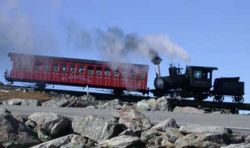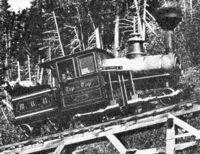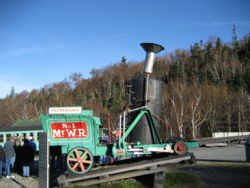Mount Washington Cog Railway
| Mount Washington Cog Railway | |
|---|---|
| Locale | New Hampshire |
| Dates of operation | 1868 – Present |
| Track gauge | 4 ft 8 in (1422 mm) |
| Headquarters | Bretton Woods |
The Mount Washington Cog Railway was the world's first mountain-climbing cog railway (rack-and-pinion railway) with a Marsh rack system. It climbs Mount Washington in New Hampshire, USA. The railway ascends the mountain beginning at an elevation of approximately 2700 feet (823 m) above sea level and ending at the summit of Mt. Washington at an elevation of 6288 feet (1916.6 m). It is the second steepest rack railway in the world[citation needed] with an average grade of over 25% and a maximum grade of 37.41%. The railway is still in operation as of 2006, using steam locomotives as it always has (most dating to the 19th century, though an experimental diesel was used between 1976 and 1981). Most of the Cog Railway is in Thompson and Meserve's Purchase, with the part of the railway nearest to Mt. Washington's summit being in Sargent's Purchase.
Contents
History
The railway was built by Sylvester Marsh, who came up with the idea while climbing the mountain in 1857. His plan was treated as insane. (Local tradition says the state legislature voted permission based on a consensus that harm resulting from operating it was no issue — since the design was attempting the impossible — but benefits were guaranteed: The $5,000 of his own money he put up, and whatever else he could raise, would be spent largely locally.) The railway is sometimes called Railway to the Moon because one state legislator remarked during the proceedings that Marsh should not only be given a charter up Mt. Washington but also to the moon. After developing a prototype locomotive and a short demonstration section of track, he indeed found investors and started construction.
Despite its incomplete state, the first paying customers rode in 1868; the construction reached the summit in 1869. The early locomotives all had vertical boilers, like many stationary steam engines of the time; the boilers were mounted on trunnions allowing them to be held vertically no matter what the gradient of the track. Later designs introduced horizontal boilers, slanted so they remain close to horizontal on the steeply graded track.
The first of two major accidents in the railway's history occurred in 1929. The first locomotive, #1 (first named Hero and later Peppersass because of its vertical boiler's resemblance to a pepper-sauce bottle) which was used to build the railway was found after being lost for many years as it had been moved about the country and placed on display at many exhibitions. The owners of the railway at the time (the B&M Railroad) decided to restore Peppersass and make a commemorative trip for the railway's 60th anniversary. During the ascent, the locomotive's front axle broke and the locomotive began descending the mountain at high speed. All but one of its crew jumped to safety (though some suffered broken bones) but one man did not escape and died. Although the locomotive broke into pieces, the boiler did not rupture, and the pieces were later reassembled to reconstruct the locomotive for static display. It is now located at the Cog Railway Base Station.
On September 17 1967, eight passengers were killed and seventy-two injured when Engine #3 derailed at the Skyline switch about a mile below the summit. The engine rolled off the trestle while the uncoupled passenger car slid several hundred feet into a large rock. An investigation revealed that the Skyline switch had not been properly configured for the descending train. Despite these incidents the railway still has a solid safety record having taken almost five million people to the summit during its existence.
Devil's shingle
Since the early days of the railway's construction the workers wanted to minimize time when climping and descending the ramp, so they invented slideboards fitting over the cog rack and providing enough room for themselves and their tools. These boards – no two were exactly alike – were approximately 90 cm long by 25 cm wide, made of wood with hand forged iron and with two long hardwood handles usually attached at the down-mountain end.
Common times for the descent of the mountain using these boards were about 15 minutes, during competitions sometimes less than three minutes were reported – that equals a speed of nearly 100 km/h (62 mph)!
The banning of the Devil's shingles came in 1906 after the death of an employee by accident. Later the design of the rack was changed so the old braking mechanism could not grip any more.
Mechanical design
Each train consists of a locomotive pushing a single passenger car up the mountain, and descending the mountain by going backwards. Both locomotive and car were originally equipped with a ratchet and pawl mechanism engaged during the climb that prevents any roll-back; during descent, both locomotive and car are braked. Recent improvements in design have replaced the ratchet (gear and pawl mechanism) with sprague clutches and disc brake assemblies.
The rack rail design used is one of Marsh's own invention, using a ladder-like rack with open bar "rungs" engaged by the teeth of the cog wheel. This system allows snow and debris to fall through the rack rather than lodge in it. (A very similar system was invented in Switzerland and named the Riggenbach rack system.) Count Riggi (Niklaus Riggenbach?) visited Marsh while he was constructing the railway up Mt. Washington and Marsh gave him copies of all of his plans.
Initially there was no way to pass. In 1941 a nine-motion switch was invented, and two spur sidings were added, each long enough to divert two up "trains" so others could pass down, enabling more round trips per day.
In 2004 work was completed replacing the lower, "Waumbek Switch and Siding", with an 1800-foot passing loop equipped with electric and hydraulicly powered automated switches. These switches are powered by batteries and recharged by solar panels. One switch is located at each end of the "loop" allowing ascending and descending trains to pass one another.
Modern operations
The most common trips on the Cog are between the two main stations, one at the summit and the other adjacent to the operators' logistical and repair "base". As of 2003, late fall "ski trains" were introduced, climbing well under half the track to an intermediate station from which skiing back to the base station is convenient for adequately-skilled passengers.
In combination with the many hiking trails, and private autos and commercial vans driving the toll-road on the northeast face of Mt. Washington, itineraries combining more than one transportation mode can be worked out. For instance, the strongest hikers may be driven early in the day to a trailhead, while most of the party takes the Cog, and someone drives the group's car around the mountain to the van terminal on the summit. The party can rendezvous at the summit, with hikers of lesser endurance joining those who hiked up for a descent on foot, and non-hikers descending by van or car.
The "Cog" track crosses a hiking trail a relatively short distance below the summit of Mt. Washington, and some hikers make a point to wait for the next train, in order to moon the train. Some reports describe painful injuries resulting from hot coals tossed in retaliation by train crewmembers.
Access to the base station by car is by three possible routes, each culminating with the upper portion of the dead-end "Cog Base Road". The advertised, roughly eastbound route uses the Base Road's full length from Bretton Woods. An especially scenic route, initially southbound from U.S. Highway 2, follows Jefferson Notch Road, a narrow dirt road with hairpin turns; it rises 1500 feet (500 meters) to the pass, at 3000 feet (1000 meters) above sea level, between Mount Jefferson in the Presidential Range and Mount Dartmouth, before descending to its junction with the Base Road. However, in winter, and usually before and after, the Jefferson Notch Road is closed to wheeled vehicles and used primarily by snowmobiles. The initially roughly northbound route from U.S. Highway 302 in Crawford Notch via Mt. Clinton Road is also closed in the winter to vehicular traffic. Due to the operations of trains all winter beginning in 2004-2005 the Cog Base Road is now plowed and sanded all winter to allow tourists, skiers and employees to access the Base Station.
Environmental concerns
The locomotives on the railway generate large amounts of smoke. The smoke has aptly been nicknamed Cog Smog [2].
Locomotives
| Number | Name | Image | Builder | Type | Date | Notes |
|---|---|---|---|---|---|---|
| 1 | Mt. Washington | Manchester Locomotive Works | 1883 | Was the first #7 Falcon; renumbered to 1 following rebuilding after the 1895 fire. Renamed Mt. Washington after 1931. Currently stored out of service at the shops. | ||
| 2 | Ammonoosuc | 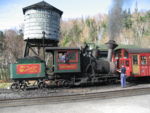
|
Manchester Locomotive Works | 1875 | Was second #4 Atlas; renumbered to 2 following rebuilding after the 1895 fire. Named Ammonoosuc after 1931; | |
| 3 | Agiocochook | 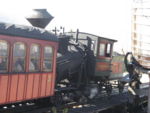
|
Manchester Locomotive Works | 1883 | Originally #2 of the Green Mountain Cog Railway. Was the third #5, not named; became the third #3 in 1934. Renamed Agiocochook in 1995/96 | |
| 4 | Chocorua | 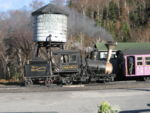
|
Manchester Locomotive Works | 1883 | Originally #1 of the Green Mountain Cog Railway . Became the third #4 | |
| 6 | Kancamagus | 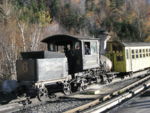
|
Manchester Locomotive Works | 1874 | Originally built as first #6 Tip-Top with vertical boiler. Rebuilt into second #6 in 1878 with horizontal boiler. | |
| 8 | Moosilauke | Mt. Washington Cog Railway Shop | 1983 | Uses a larger, welded boiler built by Monroe Boiler | ||
| 9 | Waumbek | Manchester Locomotive Works | 1908 | First horizontal boilered engine to have the cab on the same plane as the boiler. Currently being converted to burn biodiesel | ||
| 10 | Kroflite | 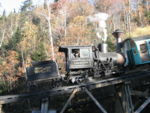
|
Mt. Washington Cog Railway Shop | 1972 | Uses a larger, welded boiler built by Monroe Boiler. Has the cab tilted on the same plane as the boiler. Converted to burn oil for a short time and converted back to coal. |
See also
- Manitou and Pike's Peak Railway - America's other cog railway
- Heritage railway
- List of heritage railways
- NH Historical Marker # 45: Cog Railway
- Mount Washington Auto Road
External links
- Mount Washington Cog Railway web site
- http://www.mtwashingtoncograilway.com
- http://www.mountwashington.com/cog/
- Maps and aerial photos
- Street map from Google Maps, or Yahoo! Maps, or Windows Live Local
- Satellite image from Google Maps, Windows Live Local, WikiMapia
- Topographic map from TopoZone
- Aerial image or topographic map from TerraServer-USA
References
- ↑ Mount Washington Cog Railway - Technology. Retrieved on November 23, 2005.
